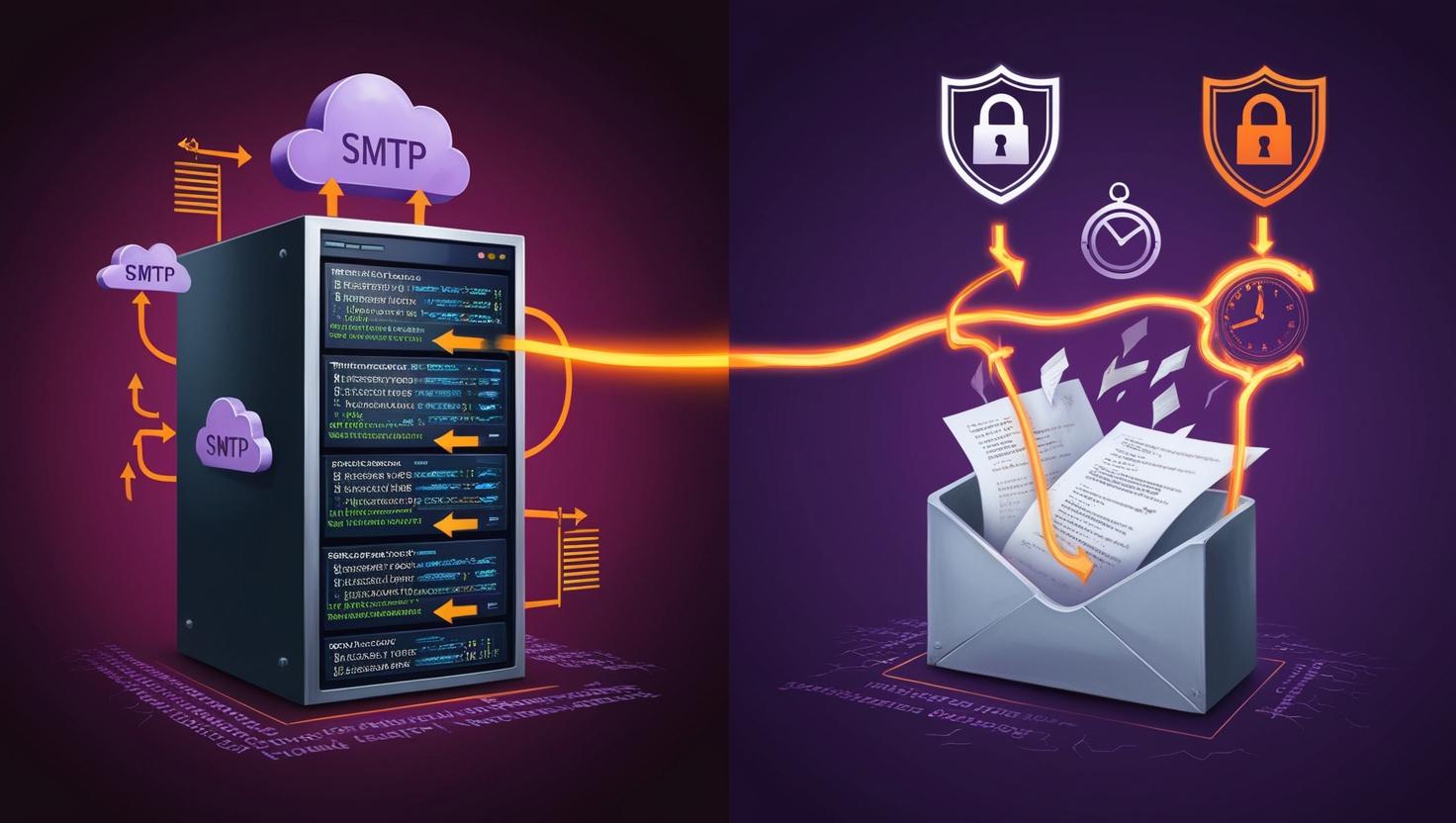SMTP Protocols and Temporary Email: Understanding the Backend Infrastructure

The hidden technical infrastructure powering temporary email services
The Invisible Architecture: How Temporary Email Actually Works
When you generate a disposable email address with 15MinMail or similar services, the process seems almost magical in its simplicity—click a button, receive an address, and start communicating. This apparent simplicity, however, masks an intricate web of protocols, servers, and technical systems working in concert behind the scenes.
Temporary email services represent a fascinating intersection of conventional email infrastructure and innovative privacy-focused adaptations. Understanding this backend architecture not only satisfies technical curiosity but also helps users make more informed decisions about their digital privacy tools.
In this comprehensive exploration, we'll pull back the curtain on the technical foundations of temporary email services, examining the protocols that power them, the unique challenges they face, and how modern solutions like 15MinMail have engineered robust systems to overcome these obstacles.
SMTP: The Foundation of All Email Communication

The fundamental flow of email transmission through SMTP
At the heart of all email communication—whether temporary or permanent—lies the Simple Mail Transfer Protocol (SMTP). Developed in the early 1980s and standardized in RFC 821, SMTP remains the fundamental protocol responsible for transmitting messages between servers across the internet.
The Basic SMTP Transaction Flow
Despite decades of technological advancement, the core SMTP transaction remains elegantly straightforward:
Connection Establishment: The sending mail server establishes a TCP connection with the recipient's mail server, typically on port 25 (or alternatively ports 587 or 465 for encrypted connections).
Greeting Exchange: The servers exchange identification information and capabilities through a series of commands and responses.
Sender and Recipient Specification: The sending server declares the message's origin (MAIL FROM) and destination (RCPT TO).
Data Transfer: After negotiating the preliminaries, the actual message content is transmitted, including both headers and body.
Transaction Completion: The receiving server acknowledges receipt, and the connection either continues for additional messages or terminates.
This seemingly simple exchange belies the complexity involved in modern email delivery, especially for temporary email services that must implement additional layers of processing and security.
As our email delivery systems article explains, this basic protocol has been extended and enhanced over time to address evolving security and functionality requirements.
SMTP Extensions: Beyond the Basics
Modern email systems rely on numerous SMTP extensions (collectively known as ESMTP) to provide enhanced functionality:
- STARTTLS: Enables encryption of the SMTP connection, protecting message content during transmission
- AUTH: Provides authentication mechanisms for secure server access
- SIZE: Allows servers to declare maximum message size limitations
- 8BITMIME: Supports 8-bit character encoding for international language support
- PIPELINING: Improves efficiency by allowing multiple commands to be sent without waiting for individual responses
- CHUNKING: Enables more efficient transmission of large messages
Temporary email services must implement these extensions selectively, balancing functionality against the unique requirements of disposable communication systems.
The Unique Architecture of Temporary Email Systems

The specialized infrastructure required for temporary email services
While temporary email services utilize the same fundamental SMTP protocol as conventional email providers, their architecture differs significantly to accommodate their specialized purpose. These differences manifest across several key components of the email infrastructure:
1. Domain Management and MX Records
Unlike traditional email providers that maintain a stable set of domains, temporary email services often employ a rotating pool of domains to evade blocklists and filtering systems. This requires sophisticated domain management systems that can:
- Automatically provision and configure new domains
- Maintain proper DNS records, particularly MX (Mail Exchange) records that direct incoming mail
- Monitor domain reputation and rotate compromised domains out of service
- Balance traffic across multiple domains to prevent individual domain overloading
The MX records themselves point to specialized receiving servers configured to handle the unique requirements of temporary email traffic, including high volume, rapid turnover, and enhanced security filtering.
2. Address Generation and Management
Perhaps the most distinctive aspect of temporary email architecture is the address generation system. Unlike conventional email services where users select and maintain persistent addresses, temporary services must:
- Generate unique, random addresses on demand
- Track address creation time for expiration purposes
- Maintain mappings between frontend interfaces and backend mailboxes
- Implement cleanup routines to purge expired addresses and their contents
This dynamic address management represents a fundamental departure from traditional email systems designed around persistent user identities.
As detailed in our technical differences in email durations article, the ephemeral nature of these addresses creates unique technical challenges.
3. Storage Architecture and Data Lifecycle
Temporary email services implement specialized storage systems optimized for:
- High write volume (incoming messages)
- Short retention periods
- Automatic data expiration and purging
- Minimal indexing requirements
- Stateless operation where possible
Unlike conventional email providers that optimize for long-term storage, search capabilities, and complex folder structures, temporary email systems prioritize performance, scalability, and automatic data lifecycle management.
4. Security and Filtering Infrastructure
Temporary email services face unique security challenges, requiring specialized filtering infrastructure to:
- Block malicious content that might target anonymous users
- Prevent abuse of the service for spamming or phishing
- Manage high volumes of unsolicited or automated messages
- Balance security against the legitimate privacy needs of users
These systems often implement more aggressive filtering than conventional providers, as the anonymous nature of temporary email creates both security risks and opportunities.
Technical Challenges in Temporary Email Implementation
Implementing and maintaining a reliable temporary email service involves navigating numerous technical challenges unique to this specialized application:
1. Deliverability Barriers
Perhaps the most significant challenge facing temporary email services is ensuring reliable message delivery in an environment increasingly hostile to anonymous communication. Major email providers and services actively attempt to identify and block temporary email domains through:
- Domain reputation scoring systems
- Pattern recognition in domain names
- Behavioral analysis of sending patterns
- Explicit blocklists of known temporary email domains
Overcoming these barriers requires sophisticated technical approaches, including:
- Regular rotation of sending domains and IP addresses
- Implementation of proper authentication protocols (SPF, DKIM, DMARC)
- Careful management of sending patterns and volumes
- Strategic use of legitimate hosting providers with good reputation
As our avoid spam guide discusses, these deliverability challenges create an ongoing technical arms race between privacy services and filtering systems.
2. Scalability and Performance Under Load
Temporary email services experience highly variable traffic patterns, with potential for sudden spikes during marketing campaigns, product launches, or when featured in popular media. This requires infrastructure designed for:
- Elastic scaling of receiving capacity
- Efficient message processing pipelines
- Load balancing across multiple backend systems
- Graceful degradation under extreme load conditions
Unlike enterprise email systems with predictable user bases, temporary email services must accommodate potentially unlimited users with minimal per-user overhead.
3. Abuse Prevention and Mitigation
The anonymity provided by temporary email services creates potential for abuse, requiring technical countermeasures such as:
- Rate limiting of address generation and message sending
- Content filtering to prevent distribution of malicious material
- Behavioral analysis to identify automated or abusive patterns
- Selective blocking of particularly sensitive services
Balancing these security measures against legitimate privacy use cases represents one of the most challenging aspects of temporary email service design.
4. Data Security and Privacy Protection
Temporary email services must implement robust security measures to protect user privacy, including:
- End-to-end encryption where possible
- Minimal logging and data retention
- Secure handling of message content
- Protection against unauthorized access attempts
As explained in our email security 101 guide, these measures are essential for maintaining user trust and service integrity.
The 15MinMail Technical Approach
At 15MinMail, we've developed a specialized technical architecture to address the unique challenges of temporary email service provision while maintaining high reliability and strong privacy protection:
1. Multi-Layered Receiving Infrastructure
Our receiving infrastructure employs multiple layers of specialized components:
- Front-End MX Servers: Distributed globally to minimize latency and provide redundancy
- Anti-Abuse Filtering Layer: Identifies and blocks malicious content before processing
- Message Processing Pipeline: Handles MIME parsing, content sanitization, and storage preparation
- Distributed Storage System: Maintains messages with automatic expiration and secure deletion
This layered approach allows us to maintain high availability while implementing robust security measures at each stage of message processing.
2. Dynamic Domain Rotation System
To overcome deliverability challenges, we've implemented a sophisticated domain management system that:
- Maintains a pool of domains with varying age and reputation profiles
- Automatically rotates domains based on deliverability metrics
- Implements proper DNS configuration including SPF, DKIM, and DMARC
- Monitors blocklist inclusion and adapts accordingly
This approach allows us to maintain reliable service even as individual domains face filtering challenges.
3. Stateless Frontend Architecture
Our user-facing systems employ a stateless architecture that enhances both performance and privacy:
- No persistent user accounts or authentication requirements
- Client-side address generation with server validation
- Minimal session data stored in encrypted, time-limited tokens
- Distributed content delivery for static resources
This approach not only improves scalability but also enhances privacy by minimizing stored user data.
4. Secure Message Access Controls
Unlike some temporary email services that make all messages publicly accessible by address, 15MinMail implements secure access controls:
- Unique access tokens generated at address creation
- Required token validation for message retrieval
- Time-limited access windows
- Rate limiting to prevent automated harvesting
These measures prevent unauthorized access to messages while maintaining the convenience of temporary email.
The Technical Future of Temporary Email

Emerging technologies shaping the future of temporary email services
As email systems and security measures continue to evolve, temporary email services face both new challenges and opportunities. Several emerging technologies and trends will shape the future of this space:
1. Advanced Authentication Requirements
Major email providers increasingly require sophisticated authentication for message acceptance, including:
- Stricter DMARC enforcement policies
- Brand Indicators for Message Identification (BIMI)
- Emerging post-DMARC authentication standards
- Reputation-based filtering systems
Temporary email services must continue adapting to these requirements while maintaining their core privacy functions.
2. Encryption and Privacy Enhancements
The growing emphasis on communication privacy creates opportunities for enhanced temporary email services:
- End-to-end encryption integration
- Zero-knowledge proof systems for anonymous authentication
- Decentralized storage architectures
- Blockchain-based message verification
These technologies could strengthen the privacy guarantees of temporary email while addressing legitimate security concerns.
3. AI and Machine Learning Impacts
Artificial intelligence is transforming both sides of the email privacy landscape:
- More sophisticated filtering algorithms to identify temporary addresses
- Advanced pattern recognition in message content and metadata
- Automated security analysis of incoming messages
- Behavioral modeling to distinguish legitimate from abusive usage
Temporary email services must leverage these same technologies defensively to maintain effectiveness.
4. Regulatory Considerations
Evolving privacy regulations create both challenges and opportunities:
- Data minimization requirements align with temporary email principles
- Right-to-be-forgotten provisions support ephemeral communication
- Anti-anonymity measures in some jurisdictions create compliance challenges
- Know-your-customer requirements for digital services may increase demand for privacy tools
Navigating this complex regulatory landscape requires ongoing technical adaptation.
Practical Applications: When and How to Use Temporary Email
Understanding the technical infrastructure behind temporary email services helps users make informed decisions about when and how to use these tools effectively:
Appropriate Use Cases
Temporary email services like 15MinMail are ideally suited for:
One-time registrations: As detailed in our one-time downloads guide, temporary addresses provide perfect protection for single-use access requirements.
Marketing offers and newsletters: Protect your primary inbox from promotional content while still accessing desired offers, as explained in our primary inbox protection article.
Research and testing: When exploring new services or conducting online research, temporary addresses provide valuable separation, as our social media research guide demonstrates.
Travel and event bookings: Minimize exposure of your primary email during travel arrangements, a strategy covered in our travel booking privacy resource.
Technical Best Practices
To maximize the effectiveness of temporary email services:
Understand service limitations: Different providers implement varying expiration periods and feature sets. 15MinMail's 15-minute window provides optimal security through rapid cycling.
Consider deliverability requirements: For critical communications, verify the temporary service's deliverability to the specific domain you're interacting with.
Use alongside other privacy tools: Combine temporary email with VPNs, private browsing, and other privacy measures for comprehensive protection.
Recognize appropriate boundaries: Some legitimate services require persistent communication channels for security or functionality reasons.
Conclusion: The Technical Balancing Act
Temporary email services represent a fascinating technical balancing act between privacy protection and practical functionality. By implementing specialized adaptations of standard email protocols and infrastructure, these services provide valuable privacy tools while navigating significant technical challenges.
The SMTP protocol—designed in an era before privacy concerns dominated digital communication—has proven remarkably adaptable to these new requirements. Through clever engineering and ongoing innovation, services like 15MinMail continue to provide effective privacy protection even as filtering systems and security measures evolve.
Understanding the technical foundations of these services helps users appreciate both their capabilities and limitations. As email continues to serve as a primary digital identifier, the role of temporary email services in protecting privacy will likely grow increasingly important.
Whether you're a technical professional interested in the architectural details or simply a privacy-conscious user seeking to understand your tools better, we hope this exploration of SMTP protocols and temporary email infrastructure has provided valuable insights into this essential privacy technology.
For more information about protecting your digital privacy, explore our guides on digital hygiene, email security, and the privacy paradox facing modern internet users.